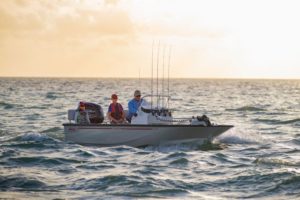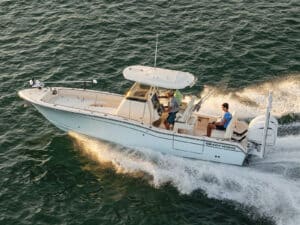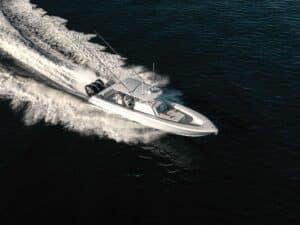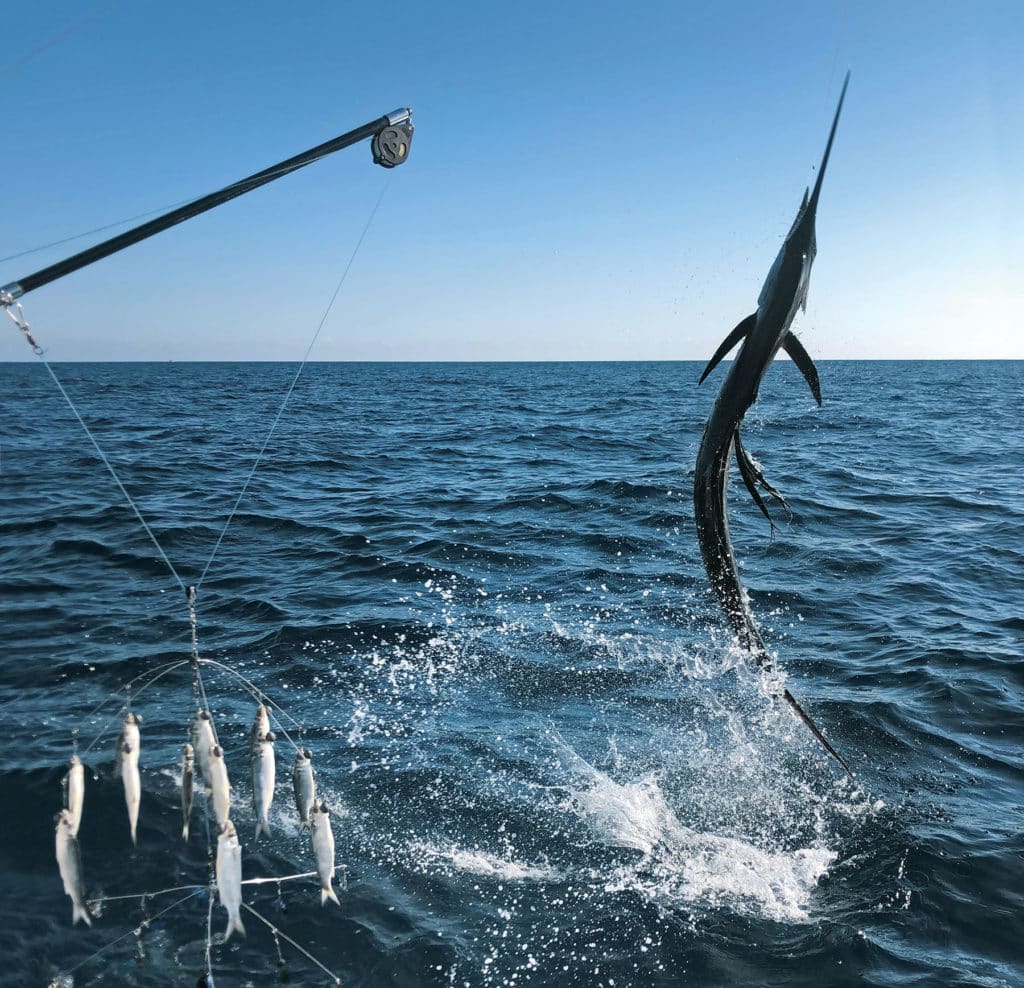
“A dredge teaser will greatly increase the productivity of any trolling spread,” says Jupiter, Florida, captain Seth Funt, who uses them to attract fish from a distance while targeting a wide range of game species, including billfish, mahi, kingfish and wahoo.
For many years, battlewagon-style sport-fishing boats dominated the practice of dredge-fishing. Their heavy-duty outriggers with tripod bases and spars with guy-wire reinforcements could withstand the strain of trolling the heavily weighted subsurface teasers. Today, however, specially designed booms allow anglers in center-console boats to pull dredge teasers, says Boone Oughterson, sales manager for Tigress Outriggers & Gear in Lake Worth, Florida.
Game Changer
Booms such as the new 7-foot fiberglass Tigress Poseidon ($649) allow anglers in any kind of boat to pull dredges in clean water out to the side, Oughterson says. “This makes it easier for fish to see the teaser, and easier for you to see fish chasing the dredge,” he observes.
Dredge booms are a game changer for smaller boats, says Capt. Pat Price, of Stuart, Florida, “especially on center-consoles with three or four outboards that generate a tremendous amount of white water.
“Not only does a boom get the dredge away from the bubbles, but it also helps keep the teaser line from tangling in the running gear.”
Dredge teasers can place tremendous strain on the boom and associated components when trolling, making setup critical.
Well-Built Booms
Today’s most advanced booms range from 6 to 8 feet in length, and feature a ring at the tip for shackling a pulley (aka block) for the line, and two rings at the midpoint (one on each side of the boom). One ring allows the captain to attach a safety tether to a secure point on the boat; the other is for creating a block-and-tackle. Top-of-the-line booms feature a ferrule at their base designed to fit an aluminum bent butt/reel seat from companies such AFTCO, Stuart and Winthrop. The butt is usually not included, giving the customer the option to buy any brand. The Poseidon, for instance, comes with a No. 4 ferrule and locking nut, which fits an 80-pound-class bent-butt section. Funt likes to use a Stuart bent butt (about $190). Price prefers a Winthrop Terminator Adjusta-Butt model (about $380) with an adjustable butt angle, which allows him to fine-tune the angle of the boom.
Electric Reels
A host of trolling reels can deploy and retrieve a dredge, but most captains use electric reels from brands such as Daiwa, Hooker and Lindgren Pittman. This eases the task of reeling in a heavy dredge. Oughterson uses his Lindgren Pittman S-1200 electric reel (about $5,000). Funt, on the other hand, uses a Hooker Gen II Shimano Tiagra 80WA levelwind reel (about $4,900). Both Funt and Oughterson spool up with 400-pound-test monofilament for dredge-fishing. To use an electric reel, you also need a 12-volt DC receptacle conveniently located in the cockpit.
Placement and Security
Most captains place dredge booms in a 15-degree gunwale rod holder that’s near midship and oriented perpendicular to the centerline of the boat. That means the boom is also perpendicular to the centerline, while the force on the boom pulls astern. At trolling speeds of 7 to 8 mph, that generates a tremendous amount of torque on the rod holder, Price points out. “You definitely want to use a top-quality rod holder, and make sure it is through-bolted and reinforced with a backing plate,” he advises.
As indicated earlier, dredge booms come equipped with a ring for attaching a safety lanyard to alleviate stress on the boom and rod holder. The Poseidon boom, for example, comes with a 14-foot woven nylon cord with a carabiner that attaches to the forward-facing safety ring
The other end of the safety lanyard should be attached to a spring cleat about 6 feet in front of the boom, Price says.
Block-and-Tackle
Dredges can be deployed with the line running just through a block at the end of the boom and directly to the teaser, or by using a block-and-tackle that adds a secondary pulley. With the Poseidon, for instance, the second pulley is attached with a short line to the aft-facing ring in the middle of the boom. The line runs through the block at the tip, then down through the secondary block and out to the dredge. Tigress offers an optional block-and-tackle kit ($149) for this rigging.
The first method works well when using lighter sinkers and/or lightweight Mylar-strip dredge teasers, Price says. However, as weights increase, the block-and-tackle makes sense. “Use the block-and-tackle to make it easier to retrieve the dredge,” Price says.
Read Next: Fishing with Dredges from Small Boats
Dredge booms can serve in others’ angling roles as well. “Many anglers use them as downriggers too,” Funt says. “The difference is that we use 100-pound-test braided line on the reel, instead of monofilament, to reduce line drag.”
What’s more, a boom can pull any kind of teaser, not just a dredge. “You can also pull linear squid chains,” Price points out. “Just as with the dredge, the boom puts squid teasers in clean water to work more effectively in attracting gamefish.”
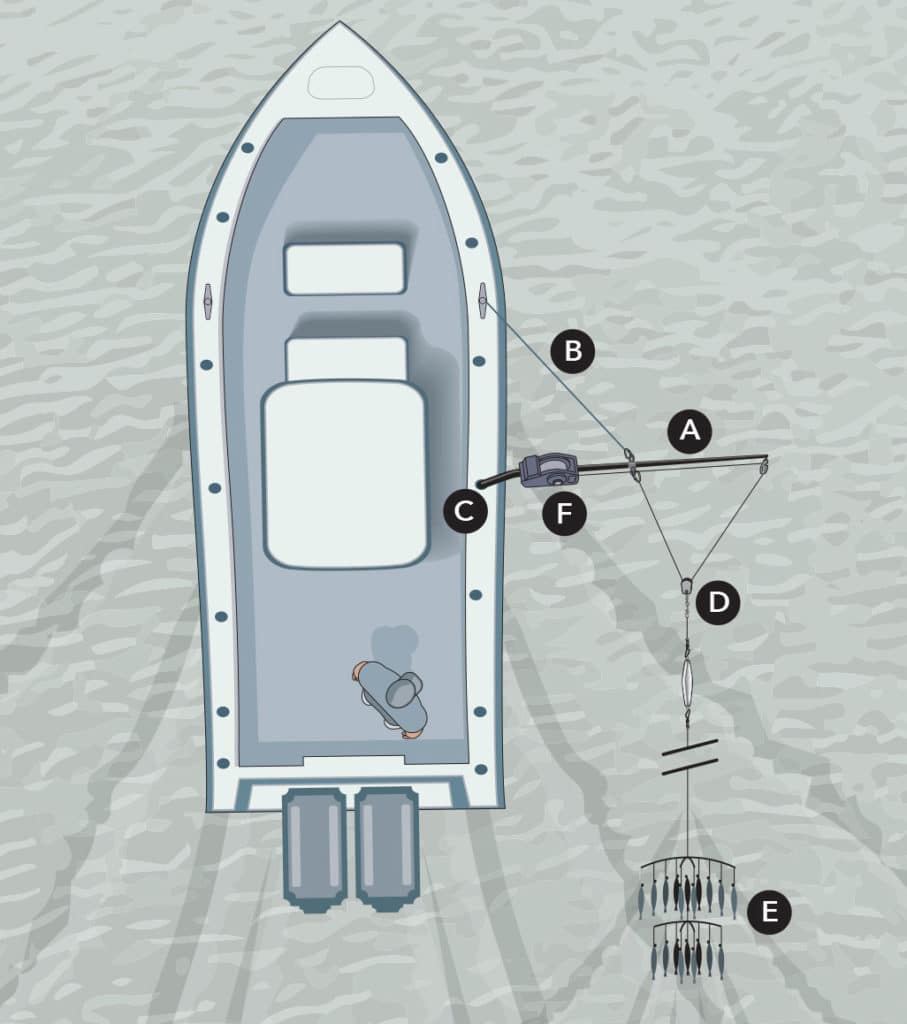
The Art of the Dredge
First employed in the early 1990s, dredges were designed to replicate a school of baitfish. Today, they take on a wide range of configurations. Dredges can feature reflective Mylar strips, soft-plastic swimbaits, rubber squid or rigged natural baits such as mullet, sometimes trailed by a lure such as an Ilander. Captains commonly pull dredge teasers from both sides of the boat, along with a full trolling spread.
Dredges are pulled behind a trolling lead, typically ranging from 6 to 48 ounces (depending on sea conditions), and a six-arm spreader bar that spans 3 to 4 feet in diameter. In addition, some captains run two or three dredges in tandem, deploying them 30 to 150 feet behind the transom, again depending on sea conditions.

